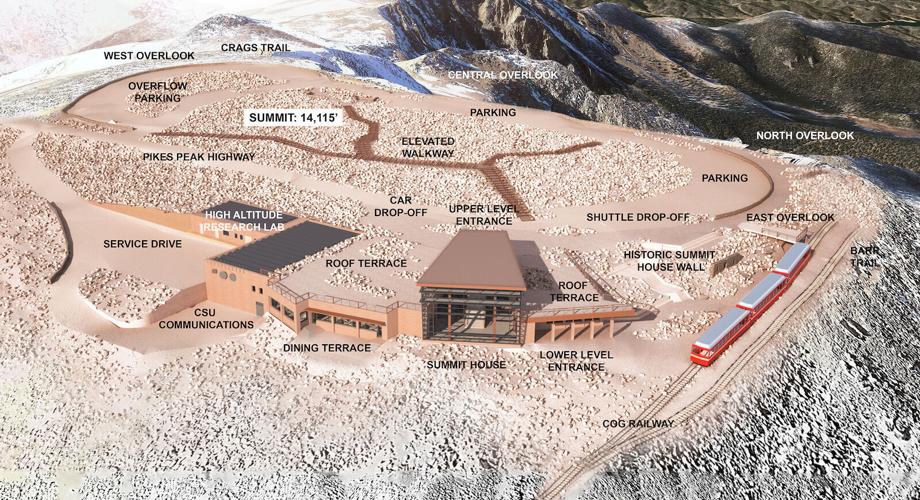Take a look inside the new summit complex atop Pikes Peak as architects close in on completing construction. (Video by Katie Klann)
Update: Pending weather and construction progress, the Pikes Peak Summit Complex is set to open June 24. A ribbon-cutting is planned for June 30.
Knowing his Colorado Springs firm, RTA Architects, would not be able to undertake the project alone, Stuart Coppedge sought partners at GWWO Architects, experts in structures for national parks. In the spring of 2015, Coppedge flew to Baltimore to dine with the team and talk about a new visitor center at 14,115 feet.
It would be a logistical nightmare, the architects agreed.
“We knew it was going to be very, very difficult,” Coppedge said. “But we mostly talked about how important it was.”
This would be an engineering marvel. An achievement hardly matched in the world’s historical record. A building to celebrate America’s Mountain, to make visitors’ jaws drop and to make proud the people of a region who take ownership of their regal backdrop.
“A national landmark and local treasure,” Coppedge said.
After six years of head-scratching groundwork and backbreaking construction, the Pikes Peak Summit Complex is poised for its debut summer.
After glimpses at tantalizing art renderings, visitors finally will enter the glass and steel edifice tucked into the summit’s craggy, southeast corner.
The often-cramped, cabin-like predecessor from 1964 is gone, replaced by something triple in size, with all the bells and whistles of the modern age. It’s about $65 million in the making.
“It’s finally the kind of structure this mountain deserves,” said Tim Redfern, construction manager with Springs-based GE Johnson.
Where the old summit house hung black and white photographs, now there are interactive displays telling the story of the mountain — a dedicated museum, complete with a short film.
More interpretive signage is posted outside, along an extensive walkway circulating the summit. Elevated above the tundra, the paths lead to various intrigues and overlooks. On the north side, a platform juts out from the summit close to 20 feet, high above the imposing Bottomless Pit.
“That north overlook gives you that Titanic moment,” said Jack Glavan, manager of Pikes Peak — America’s Mountain, the funding enterprise. “I think some people are gonna be hesitant to actually walk out there.”
The overlook showcases one pillar of the project: accessibility, granting the thrills of 14,000 feet to people of all abilities.
Pikes Peak Highway drivers will park and enter from the complex’s upper level. The view from the “grand staircase” emphasizes Mount Rosa and the Arkansas River valley, prominent points of Zebulon Pike’s expedition. Visitors can also descend via elevator.
The lower entrance is situated at the new drop-off for The Broadmoor Manitou and Pikes Peak Cog Railway. Those passengers will walk into the museum, retail and dining centers — “and those magical restrooms,” Coppedge said jokingly.
The two most common questions from public feedback, according to Coppedge: “Are the restrooms gonna be better? And will I still be able to buy a doughnut?”
Yes to both. The doughnuts will continue thanks to a new, 1,500-pound machine. But the menu is expected to trend healthier, greener. That’s in line with the project’s environmental pillar.
The aim is to meet the Living Building Challenge, an industry set of standards for renewables. Along with designs to reduce energy, the complex is equipped with a rare system to treat and return water to toilets.
Just as impressive as the ideals: the physical willpower required atop the summit since 2018’s groundbreaking.
“Super tough” is how Redfern describes the GE Johnson craftsmen and women.
They’ve endured dizzying altitude sickness, the bitter cold of winter, the harsh sun of summer and gale-force winds across seasons (building materials were tested in tunnels to withstand gusts of 230 mph).
Workers were selected after fitness exams that included stair-stepping and weighted sleds. Still, the most fit were tested by the whims of nature. On the job, they were assigned buddies and worked side by side. They carried monitors that warned them of lightning. Medical personnel were stationed at all times, Redfern said.
Going into the project, his company found only one source of advice worldwide: Peruvian miners laboring near 15,000 feet.
“It’s been everything and more than we thought,” Redfern said of the job.
Surely, he was ready to be finished.
“Yes and no,” he said one morning during his high, winding commute. “I’ve gotten to see a lot of cool sunrises and sunsets.”
















(0) comments
Welcome to the discussion.
Log In
Keep it Clean. Please avoid obscene, vulgar, lewd, racist or sexually-oriented language.
PLEASE TURN OFF YOUR CAPS LOCK.
Don't Threaten. Threats of harming another person will not be tolerated.
Be Truthful. Don't knowingly lie about anyone or anything.
Be Nice. No racism, sexism or any sort of -ism that is degrading to another person.
Be Proactive. Use the 'Report' link on each comment to let us know of abusive posts.
Share with Us. We'd love to hear eyewitness accounts, the history behind an article.